Agile vs. Waterfall: Choosing the Right Development Methodology for Custom Software Projects
In the world of custom software development, picking the right approach is essential. Agile and Waterfall, two well-known approaches, contrast with one another. Each has advantages, procedures, and guiding principles of its own. Making a decision between them necessitates being aware of their distinctions as well as being in line with project specifications and corporate culture. Compare and contrast Agile and Waterfall methodologies in the context of custom software development, highlighting their respective benefits and drawbacks.
Waterfall Methodology:
The Waterfall methodology develops software in a sequential, linear fashion. Gathering requirements, designing, implementing, testing, deploying, and maintaining it are its separate phases. Every stage must be finished in order to move on to the next, like a waterfall where development flows downhill.
The simplicity and structure of Waterfall is one of its main advantages. The definition of requirements at the outset ensures predictability and clarity. This makes it appropriate for projects with consistent needs and well-defined goals, such developing basic apps or undertaking initiatives subject to legal restrictions.
Waterfall’s inflexibility, meanwhile, may sometimes prove to be a liability. It can be difficult to go back and make adjustments once a phase is finished without interfering with later ones. If requirements change while the project is being developed, this lack of flexibility may cause delays and higher expenses.
Agile Methodology:
Agile, on the other hand, places a strong emphasis on adaptability, teamwork, and iterative development. It places a high priority on producing working software in brief, incremental cycles called sprints. Usually lasting two to four weeks, a sprint consists of planning, developing, testing, and reviewing.
Agile’s capacity to swiftly adjust to shifting needs and input is one of its main
advantages. Agile facilitates ongoing training and course correction by dividing the project into digestible sections. Because of this, it is perfect for projects whose requirements change over time, like software products in dynamic sectors or those whose features are driven by the user.
Agile encourages cooperation amongst stakeholders, engineers, and designers in cross-functional teams. Frequent gatherings, including sprint reviews and daily stand-ups, encourage openness and coordination and produce results that are of a higher caliber.
Agile has its share of difficulties. The focus on flexibility can occasionally result in scope creep or make it more difficult to determine project schedules with accuracy. Furthermore, Agile calls for stakeholders to actively participate in the development process, which may not always be possible in particular settings.
Choosing the Right Methodology:
The decision to choose Agile vs Waterfall is influenced by a number of variables, such as the project’s needs, schedule, finances, and company culture.
Waterfall may be the best option for projects with consistent objectives and well-defined needs. Its linear methodology makes it simpler to anticipate timeframes and manage resources by offering a clear roadmap from conception to delivery. This works especially well for initiatives with set deadlines and budgets, such as those in regulated industries.
Agile, on the other hand, works better on projects where creativity and flexibility are crucial or where the requirements change over time. Because iterative development allows for frequent input and revisions, the final product is guaranteed to properly fulfill consumer needs. Agile is also a good fit for projects that emphasize teamwork and ongoing development since it encourages creativity and adaptation among team members.
A hybrid strategy that incorporates aspects of both approaches might be acceptable in some situations. For example, a project might begin with a waterfall methodology for requirements collection and preliminary planning, then switch to an agile methodology for development and testing. This hybrid architecture incorporates flexibility and iterative improvements while allowing for upfront clarity.
The secret is to evaluate the project’s and the organization’s unique demands while taking into account variables including complexity, uncertainty, stakeholder engagement, and intended results. Custom software projects can optimize their chances of success and successfully provide value to stakeholders by matching the selected technique with these factors.
